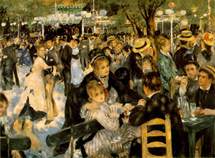Hard up in New York? Pawn your Renoir
Paola Messana
NEW YORK, Paola Messana - Pity the world's rich: as the credit crunch bites, they too are heading to the pawnbroker's -- albeit with a Renoir or Van Gogh under their arm.
New York pawn shops dealing with art collectors are at the refined end of a market more accustomed to seeing loans exchanged for an old watch, a television or family jewelry.

"There is a large liquidity crisis at the moment. Banks are limiting their lending," said Meghan Carleton, a banker at Art Finance Partners, with offices in a small art gallery on the seventh floor of an Art Deco skyscraper near Central Park.
According to Carleton, pawning art goes back to the legendary Medici family of power brokers, bankers, rulers and art patrons who lived in Florence between the 14th and 18th centuries.
But it's the modern recession and banking crisis that is driving her business.
"We have seen an increase in the last six to eight months," Carleton said. "Up to 40 percent of our clients are new ones, or old (ones) who bring more things."
Unlike less privileged debtors, someone pawning a valuable art work doesn't actually push the canvas across a counter.
"Our borrowers keep their properties at home," another art loans specialist, who asked not to be identified, told AFP.
"If they default, we can sue them and force them to sell even their house. Every loan is personally guaranteed by the borrower."
The revelation in The New York Times earlier this year that photographer Annie Leibovitz had taken a 15 million dollar loan from Art Capital Group by pawning her own work caused a scandal in this secretive corner of the finance world.
Carleton said she would never reveal customers' identities, although she said they come from all over the world and some "are famous."
"They leverage art not necessarily to repay debts," she said. "It can be to launch a new business, or to buy another piece of art."
But "all of them require anonymity. In divorce cases, for example," she added.
The system is similar to traditional pawn brokering, only on a greater scale.
A client pawns a work of art and secures a loan amounting to 40 percent of its estimated value.
The loan is usually short term, but can be longer in some cases, according to the website of Fine Art Finance, which is part of Emigrant Bank.
The debtor pays a hefty interest of between 12 to 19 percent of the value of the loan. In case of default the debtor loses the piece and, potentially, other assets -- something that happens in about 15 percent of cases, according to Carleton.
A handful of institutions -- including Art Capital, Art Finance Partners and Fine Art Finance -- operate in New York, generally with no more than five partners.
The art loans specialist who did not want to be identified said that major banks had got out of the business.
"Deutsche Bank, Citi or Bank of America occasionally made art loans, or loans secured by musical instruments. That is no longer the case. Many banks lost gigantic amounts in the 1970s and in the 1990s," she said.
"It's a very scary kind of loan," she said. "The art market is wild, not transparent at all, perfect for irregular activities".
The specialist said that her own institution makes loans above one million dollars and will accept only entire collections -- whether paintings, furniture, or stringed instruments -- that are worth at least five million dollars as collateral.
"Since 2008 we have seen an increase in inquiries of one and a half to two times," she said.
"We don't have losses in our portfolio. We are very very over-collateralized."
--------------------------------------------------------------------------------------------------------------